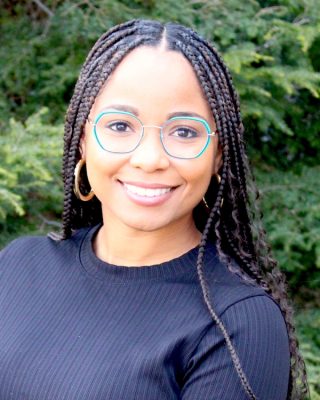Courtney Mauldin infuses her scholarly research with a clear purpose: to give Black girls innovative opportunities to dream big and envision futures filled with possibilities. Her involvement with the Central New York Humanities Corridor is critical to success: “We see the humanities as something that allows for dreaming, and we are creating space for girls to dream through art and literature,” says Mauldin, assistant professor of educational leadership in the teaching and leadership department in the School of Education. She co-leads the Collectively Envisioning Black Girl Futures Working Group, one of dozens of working groups in the corridor.
 This fall, the corridor marks 15 years in existence and its fifth year into the endowment that provides humanities research support in perpetuity, thanks to an award from the Andrew W. Mellon Foundation. Though the administrative home of the corridor is at the Syracuse University Humanities Center, the corridor is a consortium of 11 institutions connecting faculty, academic staff, students and members of the wider community across disciplinary, geographic and institutional boundaries.
This fall, the corridor marks 15 years in existence and its fifth year into the endowment that provides humanities research support in perpetuity, thanks to an award from the Andrew W. Mellon Foundation. Though the administrative home of the corridor is at the Syracuse University Humanities Center, the corridor is a consortium of 11 institutions connecting faculty, academic staff, students and members of the wider community across disciplinary, geographic and institutional boundaries.
“The corridor has truly become a regional consortium with global reach,” says Vivian M. May, director of the Humanities Center and the corridor, and professor of women’s and gender studies. “Thanks to our support this past year, working groups engaged with over 3,800 individuals and collaborated with over 260 institutions and organizations across at least 37 states and 23 countries around the world.”
With funding from the corridor, Mauldin has been able to bring together educators and others who aspire to mentor Black girls to explore ways to give them more voice. As part of their research (the working group is now in its third funding cycle), Mauldin and her co-lead Misha Inniss-Thompson, assistant professor in the department of psychology at Cornell University, discovered that the adult educators first needed to explore their own beliefs, backgrounds and judgments and “discover the Black girl in all of us and unlearn some of what we had learned as girls” to more effectively mentor and inspire the next generation.
“In a world where we are constantly bombarded with messages of who we ought to be (or not), in the working group we’ve cultivated a space that truly begins to embody what it means to express our thoughts freely, make space for our healing and co-construct spaces where current generations of Black girls can have a space to be in intentional community with one another,” says Inniss-Thompson.
Now, each event sponsored by Mauldin’s working group has an intergenerational element. “The corridor has given us an opportunity to do the kind of applied research that doesn’t fit into a box,” says Mauldin. “We go in with one idea and discover something new, always thinking about impact.” At an upcoming exhibition at the Herbert F. Johnson Museum of Art in Ithaca, New York, the art of Nydia Blas will be used as a springboard for participants to consider the role of family, history and home in shaping understanding of Black girlhoods.
“The corridor brings to life our commitment as stated in the Academic Strategic Plan to support and encourage research focused on the community good and fosters empathy and civic engagement through the arts and humanities,” says Associate Provost for Strategic Initiatives Marcelle Haddix. “Together with our academic colleagues across Central New York, we grapple with critical questions and address issues that have the potential to transform society in positive ways” …
